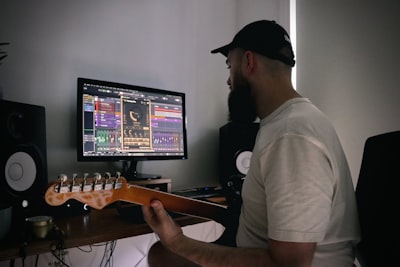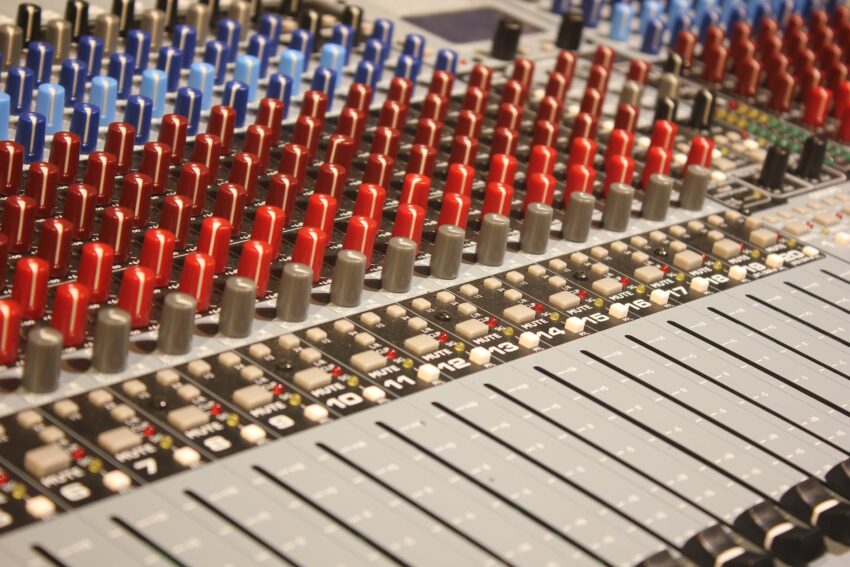Game Audio Mixing and Mastering
As a game developer, you know how important it is to create Game Audio Mixing and Mastering. One crucial element that often goes unnoticed is the mixing process of game audio. The right mix of music, sound effects, and voiceovers can make or break a game’s success. In this guide, we will cover everything you need to know about game audio mixing and mastering. We’ll start with the basics of game audio and why it’s so important in gaming.
Then we’ll dive into the process of game audio mixing, covering volume balancing techniques, effective panning and width control, and crafting the perfect tone through equalization. Once your mix is complete, we’ll move on to mastering in game audio where we’ll discuss minor EQ adjustments and getting the right loudness standards for your final sound. We’ll also explore how game audio impacts player experience and ways to continuously improve your audio mixing and mastering skills. Get ready to take your game development to the next level with this comprehensive guide!

Understanding the Basics of Game Audio
Game audio is a vital component of the gaming experience, enhancing immersion for players. Through the strategic use of sound effects and music, game developers can add depth and realism to gameplay. This is achieved through the process of mixing and mastering, which ensures that the audio is balanced and optimized.
Game audio professionals employ various techniques, such as using a mixer and equalizer, to create an engaging audio experience. Acoustic rendering and acoustics also play a crucial role in the game industry. By prioritizing accessibility and following industry standards, sound designers, composers, and audio directors collaborate to create an exceptional soundtrack that enhances the overall gaming experience.
Importance of Sound in Gaming SFX
Creating a realistic and immersive gaming experience is crucial in game development. Sound plays a vital role in achieving this goal. Audio cues provide important feedback and information to players, enhancing their gameplay. Well-designed sound effects and music not only add depth but also enhance storytelling and emotional impact.
It helps create a unique atmosphere and sense of place, immersing players further into the game world. High-quality sound design adds polish and professionalism, elevating the overall gaming experience. Utilizing industry-standard techniques like mixing and mastering, game audio professionals ensure that every detail is prioritized, resulting in a captivating auditory experience.
The Process of Game Audio Mixing
The process of game audio mixing involves a careful balance and blend of different audio elements to create an immersive and engaging experience for players. Volume balancing techniques are used to ensure that all sounds are audible and well-balanced, while panning and width control give a sense of space and directionality.
Equalization is used to shape the tone and frequency spectrum of each sound, while automation adds movement and dynamic variation to the audio mix. By utilizing these techniques, sound designers and audio directors can create a polished and professional mix that enhances the overall gameplay.
Volume Balancing Techniques
Achieving clarity and proper representation of sounds in game audio is crucial. Volume balancing techniques play a significant role in this process, ensuring that all audio elements are appropriately balanced. Proper gain staging helps maintain a consistent loudness level throughout the game, while prioritizing and balancing audio elements based on their importance ensures an optimal player experience.
Compression can be used to control dynamic range and maintain a consistent volume. Additionally, considering different platforms and playback devices allows for volume optimization. These techniques are essential for creating an immersive and enjoyable gaming experience.
Effective Panning and Width Control and Compression
Panning and width control are essential aspects of game audio mixing. By placing sounds in the stereo field, a sense of space and direction is created, enhancing the overall immersive experience for players. Adjusting the stereo width can further enhance the perceived size and depth of the audio, making it more engaging. Effective panning and width control also prevent audio masking and optimize clarity, ensuring that important sounds are prioritized in the mix for a focused and impactful audio experience. These techniques, along with spatial audio, contribute to the overall quality of game audio.
Equalization: Crafting the Perfect Tone
Crafting the perfect tone in game audio involves utilizing equalization to shape the frequency response of individual audio elements. By removing unwanted frequencies and emphasizing desired ones, clarity is achieved. It is essential to balance the tonal characteristics of different sounds to avoid muddiness and ensure they fit together harmoniously. Additionally, equalization can be used creatively to enhance specific frequencies, making sounds stand out or seamlessly blend into the mix. This process allows for the shaping of the overall sonic character of the game. Game developers prioritize equalization to create an immersive audio experience for players.
Mastering in Game Audio: Enhancing the Final Sound
Mastering in game audio is crucial for enhancing the final sound and optimizing its overall quality. Through minor EQ adjustments, the tone and balance of the mix can be further enhanced, resulting in a more immersive experience for players. Paying attention to loudness standards is important to ensure a consistent volume level across platforms and playback systems. Finalizing the audio mix for TV, PC, headphones, console, and Sony is essential for accessibility and compatibility. Quality mastering adds polish and professionalism to the game’s audio, elevating it to industry standards.
Minor EQ Adjustments and Why They Matter
Minor EQ adjustments play a crucial role in game audio mixing and mastering. They help fine-tune the EQ to address any remaining tonal imbalances in the mix, ensuring that individual sounds fit together seamlessly. By correcting frequency masking issues between different audio elements, these adjustments improve clarity and separation in the mix. Furthermore, they enhance the emotional impact and immersion of the game by allowing for precise EQ sculpting. So, don’t underestimate the importance of these minor EQ adjustments in creating a well-balanced and immersive gaming experience.
Loudness Standards: Getting the Right Volume
Adhering to industry loudness standards ensures that the game’s audio, including PlayStation titles, is consistent and compliant across different devices. Setting appropriate volume levels helps prevent audio clipping or distortion, ensuring a smooth listening experience. By considering the listening environment, such as whether players are using headphones or speakers, you can adjust the loudness accordingly. Proper loudness management is crucial for creating an enjoyable and immersive experience for players. It’s important to prioritize meeting industry requirements for consistent playback, whether on a TV, PC, or console. By following these loudness standards, game audio professionals, like sound designers and audio directors, can deliver high-quality sound that enhances the overall gaming experience.
How does Game Audio Impact Player Experience?
Game audio plays a crucial role in enhancing the player experience and engagement. Well-designed sound effects and music immerse players in the game world, creating a sense of presence and emotional connection. Strategic audio cues provide important feedback and enhance gameplay, while high-quality game audio adds professionalism and polish.
Immersion through Sound: A Crucial Element in Gaming
Creating a realistic and immersive gaming experience relies heavily on sound design. The audio quality of a game can greatly enhance the player’s emotional connection to the virtual world. By utilizing different platforms and audio techniques, game audio professionals can optimize sound for various gaming scenarios, including virtual reality. Experienced sound designers understand the importance of clarity and balance in achieving an immersive experience. Through immersive sound effects and dynamic audio mixing, the game world truly comes to life. These elements combine to provide players with an unforgettable and engrossing gaming experience.
Can Audio Quality Make or Break a Game?
The audio quality of a game can have a significant impact on the overall gaming experience. High-quality audio enhances immersion and adds depth to gameplay, while poor audio quality can detract from the enjoyment. Utilizing industry-standard techniques and equipment, along with attention to detail in sound effects and music production, ensures top-notch audio that can elevate a game from good to exceptional. Audio compression techniques also help maintain consistent loudness levels for a seamless gaming experience.
How to Continuously Improve Your Audio Mixing and Mastering Skills?
To continuously improve your audio mixing and mastering skills, it is essential to experiment with different plugins and equalization techniques. Understanding the frequency spectrum and how sounds interact will help achieve a balanced mix. Utilizing automation techniques adds movement and depth, while collaborating with industry professionals and seeking feedback fosters growth as a mixing engineer. Additionally, incorporating tools such as EQ, compression, limiting, and saturation can further enhance the quality of your audio and optimize it for different platforms and devices.
Frequently Asked Questions
How to mix music for video games?
Mixing music for video games involves several key steps. First, identify the main elements of the music and their role in the game. Then, use EQ to balance the frequency spectrum and avoid muddiness. Utilize compression to even out volume levels and add punch to the sound. Finally, experiment with panning and reverb to create a sense of space and depth. Volume balancing through the use of faders is also crucial in achieving a well-mixed game audio soundtrack.
What audio format do games use?
Games utilize various audio formats to meet different requirements. Compressed formats like MP3 or OGG are commonly used to save space, while uncompressed formats like WAV or AIFF offer higher quality. Audio file formats and compression settings should be optimized for game engines and platforms to ensure optimal performance.
What makes good video game music?
Good video game music enhances the gameplay experience, evokes emotions, and adapts to different game situations. Skilled audio engineers use mixing and mastering techniques to ensure the music sounds great on any device or platform.
Is video game music compressed?
Video game music is often compressed to reduce file size and enhance performance. Different compression techniques, such as dynamic range compression or lossless compression, can be applied to game audio. The degree of compression used depends on the specific needs and goals of the game developer.
Can music affect performance in video games?
Music in video games can indeed have an impact on performance. High-tempo music can increase heart rate and adrenaline, leading to improved reaction time and focus. On the other hand, slow and calm music can reduce stress and anxiety, enhancing decision-making skills. Game developers should consider this when designing games.
Automation Conclusion
In conclusion, game audio is a critical component in enhancing the overall player experience. By understanding the basics of game audio, mastering the art of mixing, and applying effective panning, equalization, and mastering techniques, you can create immersive soundscapes that captivate players and elevate their gaming experience. It’s important to remember that audio quality can make or break a game, so investing time and effort into continuously improving your audio mixing and mastering skills is crucial. As a game developer, you have the power to create an unforgettable auditory journey for your players, so embrace the challenge and let your creativity shine through the power of game audio.
Follow on Instagram.

